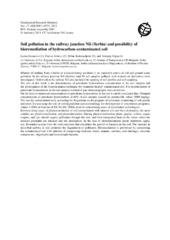| dc.description.abstract | Mineral oil leaking from vehicles or released during accidents is an important source of soil and ground water
pollution. In the railway junction Niš (Serbia) total 90 soil samples polluted with mineral oil derivatives were
investigated. Field work at the railway Niš sites included the opening of soil profiles and soil sampling.
The aim of this work is the determination of petroleum hydrocarbons concentration in the soil samples and
the investigation of the bioremediation technique for treatment heavily contaminated soil. For determination of
petroleum hydrocarbons in the soil samples method of gas-chromatography was carried out.
On the basis of measured concentrations of petroleum hydrocarbons in the soil it can be concluded that: Obtained
concentrations of petroleum hydrocarbons in 60% of soil samples exceed the permissible values (5000 mg/kg).
The heavily contaminated soils, according the Regulation on the program of systematic monitoring of soil quality
indicators for assessing the risk of soil degradation and methodology for development of remediation programs,
Annex 3 (Official Gazette of RS, No.88 / 2010), must be treated using some of remediation technologies.
Between many types of phytoremediation of soil contaminated with mineral oils and their derivatives, the most
suitable are phytovolatalisation and phytostimulation. During phytovolatalisation plants (poplar, willow, aspen,
sorgum, and rye) absorb organic pollutants through the root, and then transported them to the leaves where the
reduced pollutants are released into the atmosphere. In the case of phytostimulation plants (mulberry, apple,
rye, Bermuda) secrete from the roots enzymes that stimulates the growth of bacteria in the soil. The increase in
microbial activity in soil promotes the degradation of pollutants. Bioremediation is performed by composting
the contaminated soil with addition of composting materials (straw, manure, sawdust, and shavings), moisture
components, oligotrophs and heterotrophs bacteria. | sr |

